While the islands of Borneo and Sumatra are perhaps best known for their extraordinary array of primate species, they are by no means the only fascinating mammals founds on the islands. Borneo and Sumatra’s rainforests provide refuge to some of the most iconic species alive.
Although increasing rates of deforestation, agricultural expansion, and the illegal pet trade have forced many of these species to the brink of extinction, the following are just some of the species found.
The Sumatran tiger (Panthera tigris sumatrae) is the only remaining tiger found in Indonesia. It lives in lowland forest, sub-mountain forest, mountain forest, and peat moss forests on the island of Sumatra. The smallest of all the tiger species, male Sumatran tigers have a head to tail length of around 2.20-2.55 meters, and weigh around 100-160 kg, while females have a head and body length of 2.15-2.30 meters and weigh around 75-110 kg (Sumatran Tiger Trust). The coloring and patterns of tigers are instantly recognizable, but Sumatran tigers are the darkest of the subspecies’, ranging from reddish yellow to deep orange, and it’s black stripes are often broad and close together, an adaptation that helps it camouflage in the dense jungle. It’s undersides, and underneath its chin, are white, while the chin has a short mane, and it has striped forelegs.
Tigers are largely solitary animals, although they are not anti-social; males are occasionally seen resting with females and cubs, and they may also travel in groups (Burnie, 2001). Active at night, tigers are nocturnal animals, but will hunt during the day during cooler periods, and range over territories of 10-30 or more square miles, which they mark out by spraying their urine or a glandular secretion, by leaving fecal droppings, or by scratching marks into trees (Sumatran Tiger Trust). The ranges of males overlap with those of several females.
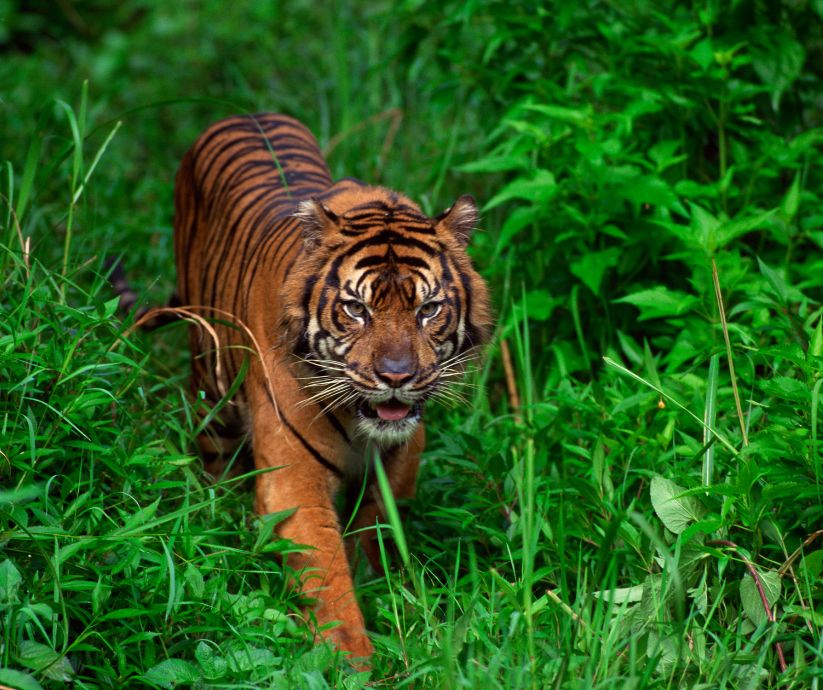
A Sumatran tiger.
Tigers are born after a gestation period of 16 weeks, and the litter usually consists of around 3-4 cubs, which are born blind and helpless, and raised entirely by their mother. Tiger cubs have a high mortality rate, due to high instances of predation, often by male tigers, who will kill cubs to make the mother sexually receptive. Tiger cubs become independent at around 18 months and will leave their mother's side at around 2-2.5 years of age. Females reach sexual maturity at 3-4 years of age, and males reach sexual maturity at 4-5 years. They have a life expectancy of around 15 years in the wild (Burnie, 2001).
Tigers are carnivorous meat eaters, and Sumatran tigers feed chiefly on different members of the deer family, pigs, rhino’s, snakes, tapirs, and other large mammals, which are usually killed in an ambush from behind, with a bite to its neck breaking the prey’s spinal cord (Sumatran Tiger Trust).
Once widespread throughout the island, deforestation and forest conversion has seen the population plummet, and there are now believed to be around 350 tigers surviving in the wild.
Elephants are the largest land mammals in the world and are distributed throughout much of Africa and Asia. There are two subspecies of the Asian elephant found in Indonesia; the Bornean pygmy elephant (Elephas maximus borneensis) and the Sumatran elephant (Elephas maximus sumatranus). Bornean pygmy elephants are restricted to the rainforests in the north and east of the island, while the Sumatran elephant is found in tropical and subtropical moist broadleaf forests throughout Sumatra (WWF, 2011).
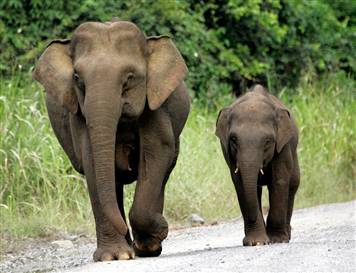
Bornean pygmy elephants.
Sumatran elephants reach a shoulder height of between 2 and 3.2 meters and can weigh between 2,000 and 4,000 kg. Unlike other elephants, males of this subspecies rarely develop long tusks, while those of adult females may be so short they are hidden by the upper lip, and they are also much lighter in color than other elephants. Bornean pygmy elephants are, hence their name, the smallest of all elephants, with males growing to less than 2.5 meters, and are identifiable by their large ears, younger-looking faces, longer tails and more rotund shape (WWF, 2011).
All elephants are herbivores, and a single Bornean elephant can eat up to 150 kilograms of vegetation every day, feasting on various species of palms, grasses and wild bananas. They also acquire minerals found in salt licks or from the mineral concentrations in limestone outcrops. Sumatran elephants will usually consume more, around 200 kilograms of vegetation a day, and will feed chiefly on bananas, ginger, young bamboo and leaves of a variety of vine (WWF, 2011).
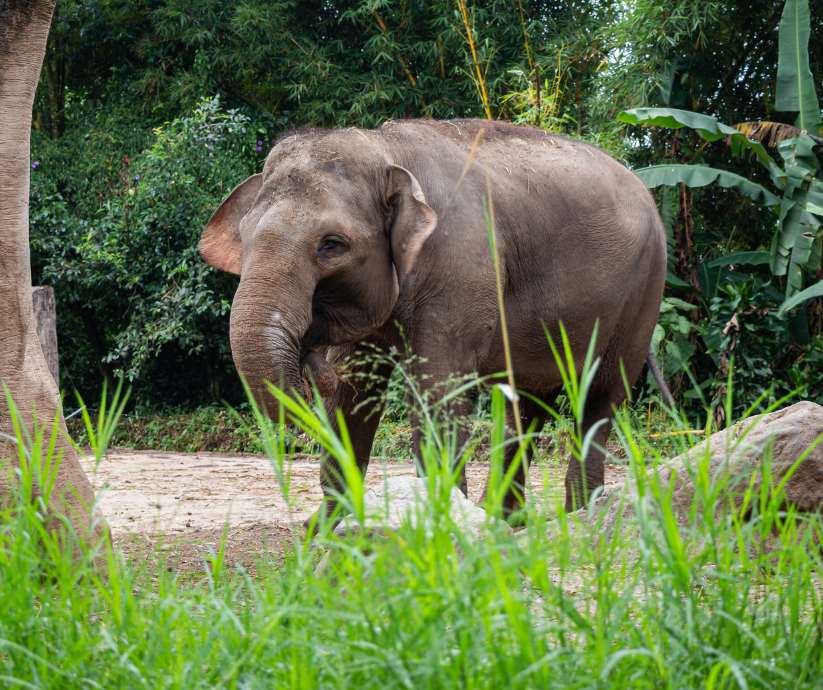
A Sumatran elephant.
Asian elephants live in small family groups consisting of a female matriarch and other related females of varying ages. Males only join such groups when females are sexually receptive and are otherwise either solitary older bulls or, when young, part of bachelor groups. Adult males have little to do with their young, which are born after a gestation period of 22 months, weaned at around 4 years old and reach sexual maturity at 9-15 years if it is female, and 12-15 if it is male (Burnie, 2001).
While African elephants have suffered from a long history of hunting, Asian elephants have a long association with humans (Bornean pygmy elephants are particularly docile), and are endangered largely due to the intense competition with people for land. Both the Sumatran and Bornean pygmy elephants are listed in Appendix I of CITES, and both face the threat of extinction due to habit loss, habitat fragmentation, and persecution as crop raiders (Burnie, 2001).
There was once thought to be just one species of clouded leopard found throughout Asia, but studies in 2006 confirmed that the species found in Borneo and Sumatra, the Sunda clouded leopard (Neofelis diardi), is distinct from the species found on the Asian mainland.
Clouded leopards inhabit tropical rainforests, with populations in Borneo inhabiting lowland forests, and populations in Sumatra largely inhabiting forests at higher elevations, in hilly, montane areas, possibly because they share their habitat with Sumatran tigers on this island (Hearn et al., 2008).
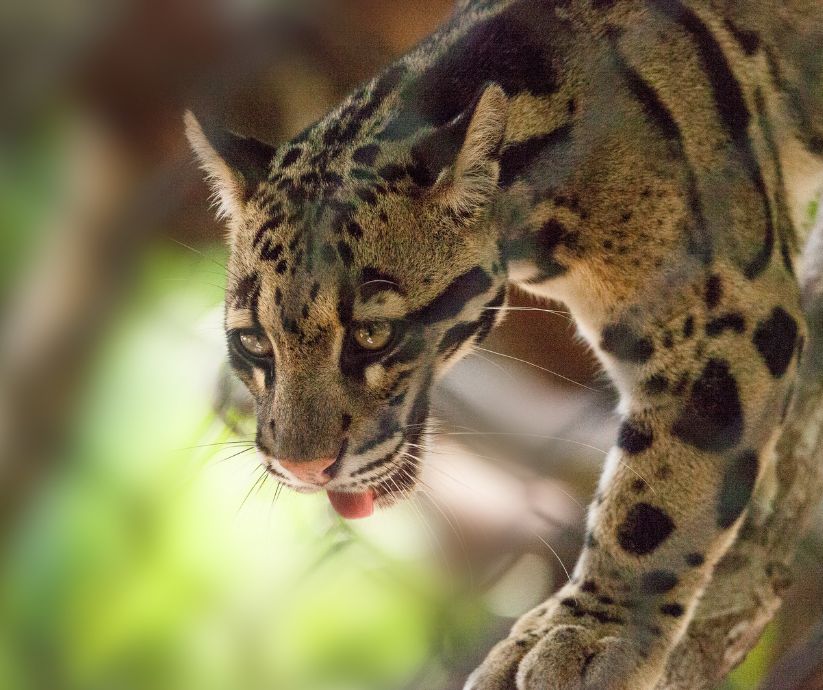
A clouded leopard.
These leopards have a stocky build and weigh between 12 to 25kg, with a head-to-body length of 50 to 110cm and a tail length of 55-91 cm. It has a dark coat covered in black-edged, darker-centered ovals, which look like clouds and gives the leopard its common name. They also have extremely long canine teeth in proportion to their skull size, and they are extremely proficient carnivores, feeding chiefly on different species of deer, bearded pigs, civet cats, monkeys, gibbons, porcupines, and fish.
The leopard is nocturnal and feeds predominantly in treetops, but will descend to the forest floor to hunt. Unfortunately, due to their shy nature, virtually nothing is known about the social structure and mating systems of the clouded leopard (Burnie, 2001; Hearn et al, 2008).
One of the most iconic animals alive, there are five species of rhinoceros found throughout Africa and Asia, with the Sumatran rhinoceros (Dicerohinus sumatrensis) divided into three further subspecies. The Western Sumatran rhino (Dicerohinus sumatrensis sumatrensis) is found in Sumatra and peninsular Malaysia, and numbers just 170-230 individuals. The eastern Sumatran rhino (Dicerohinus sumatrensis harrissoni) survives with a population of just 50 individuals, and lives in fragmented forest in the Malaysian state of Sabah on Borneo, while the Northern Sumatran rhino (Dicerohinus sumatrensis lasiotis), which once roamed throughout India and Bangladesh, is now only found in Burma, and may even be extinct there, the political situation in that country making surveys and verification difficult. Sumatran rhinoceroses live in dense tropical forest, lowland and highland, primary and secondary, and often hilly areas close to water, and steep upper valleys with dense undergrowth (van Strien et al, 2008).
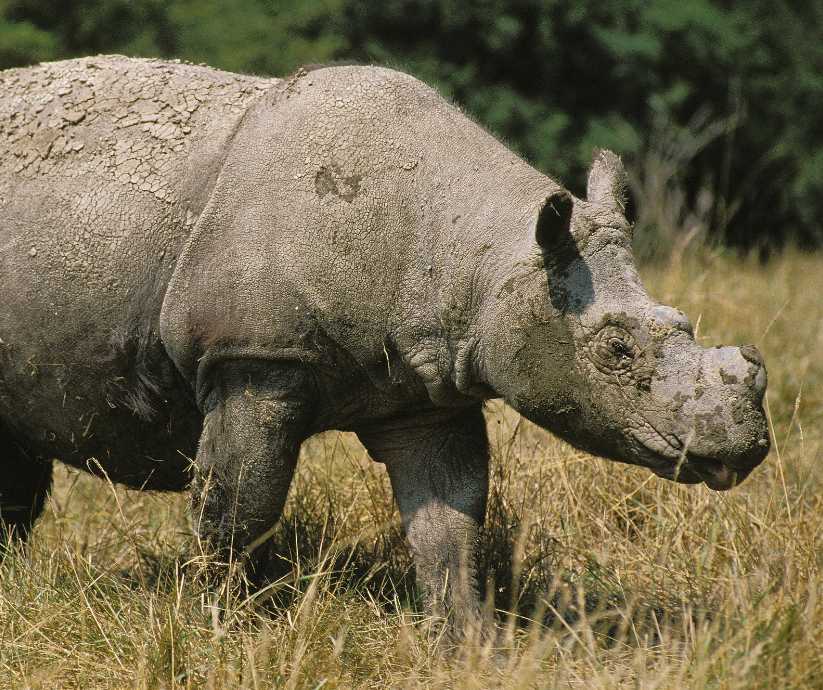
A Sumatran rhino.
Rhinoceroses are large, heavy built animals, but the Sumatran rhinoceros is the smallest species, with a weight of around 600-950kg, a height of 3-5 feet and a length of 6.5 to 9.5 feet (International Rhino Foundation). Often called the ‘hairy rhino’ due to the reddish-brown fur that covers its body, the Sumatran rhino has two horns, a large nasal horn of around 5.9 to 9.8 inches and a much smaller posterior horn of around 3.9 inches long. Rhinoceroses have a strong sense of smell, and mobile, tubular ears enable excellent hearing. However, their eyes are small and they have poor vision (Burnie, 2001).
Relatively little is known about the behavior of Sumatran rhinoceroses, but they are believed to be largely solitary. Males have home ranges of around 50 km2, which seem to overlap with those of other males, while females have ranges of 10-15 km2, which appear to be spaced out. Rhinos spend most of their day wallowing in mud to call down, and is most active when eating, at dawn and after dark, when it feeds on a diet of young saplings, leaves, fruits, shoots, and twigs. It will usually consume up to 50 kg of food a day.
Young are conceived after a consortship between a male and a female, and are born after a gestation period of 15-16 months, at which time the female raises the young independently. Young are weaned at around 15 months and will stay with their mother for the first 2-3 years of their life. Females have an inter-birth interval of 4-5 years. Males reach sexual maturity at 10 years of age, with females reaching it at between 6-7 (Burnie, 2001; International Rhino Foundation).
Bears are among the most charismatic animals on earth, but while the brown, black, grizzly, polar and panda bears are internationally known and icons of the conservation movement, many people don’t realize that bears can also be found in Borneo, Sumatra and mainland southeast Asia.
Sun bears (Ursus malayanus) are the only truly tropical bear. They live in tropical evergreen rainforests, which include areas of peat swamp, lowland dipterocarp, freshwater swamp, limestone hills, lower montane forest and mangroves, and live anywhere up to 2,100 meters above sea level (Fredriksson et al., 2008).
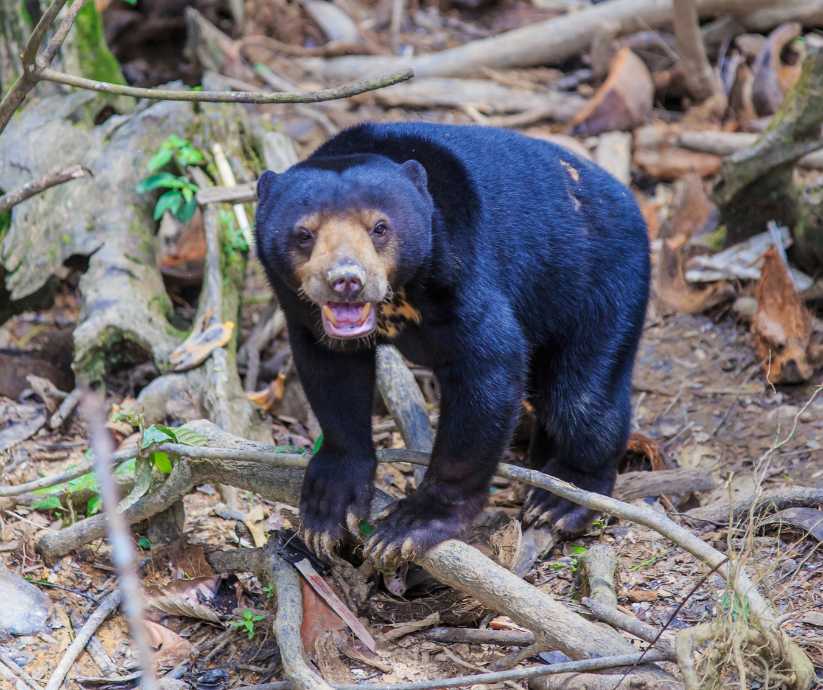
A Malayan sun bear.
Shy and elusive, little is known about the sun bear’s social structure, but they are believed to be solitary, with the largest social group consisting of a mother and her dependent offspring. Sun bears do not hibernate and can produce young all year round, with young being born after a gestation period of 96 days. Born blind and hairless, sun bears are completely dependent on their mothers for the first 18 months of their lives, and reach sexual maturity at around three years old, by which time males will weigh between 30 to 70 kg and females between 20 to 40 kg.
A nocturnal animal, sun bears are omnivores and feed chiefly on termites, ants, beetle larvae, bee larvae and a large variety of fruit species. Their propensity for eating honey has given rise to their alternative name, and the sun bear is referred to throughout Indonesia and Malaysia as the honey bear.
Sun bears have extremely long, curved claws that they use to climb trees, dig for worms and insects, and tear up logs and old bark. They do this to get at termites and remove honey from wild bees’ nests. A sun bear has a very long, 10-inch tongue that's helpful for extracting honey and grubs from holes and crevices (Burnie, 2001; Fredriksson et al., 2008).
The Malayan tapir (Tapirus indicus) is the only found tapir found in Asia and is found in Sumatra, where it lives in heavily fragmented populations in tropical moist forests.
Tapirs are large, ground-dwelling mammals, weighing around 250-540 kg, with a length of between 1.8 and 2.5 meters, and are easily identifiable by their two-tone coloring; they are black with a white saddle that extends from its shoulder to its rear and has white-rimmed ears. They have short stubby tails and long flexible noses.
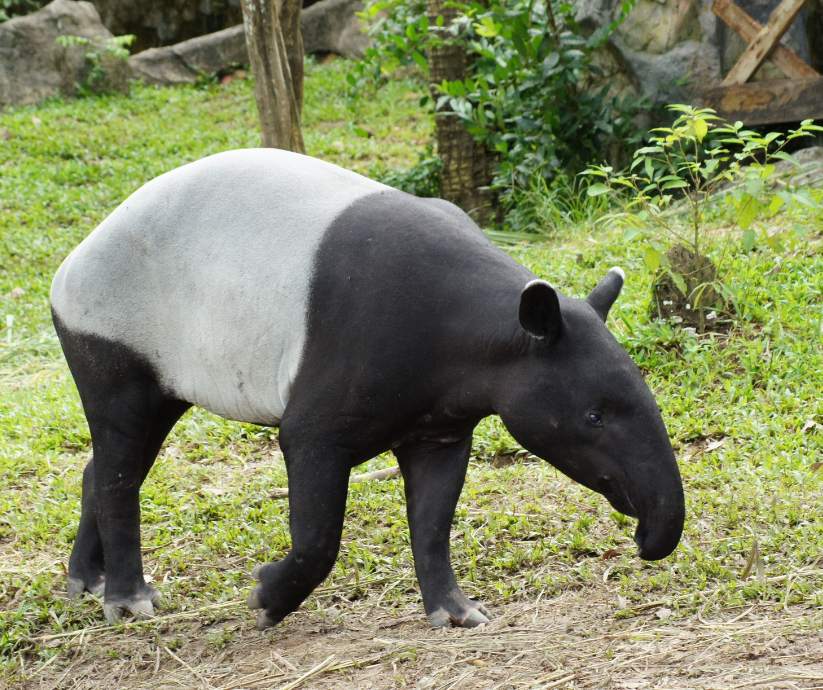
A Malayan tapir.
Malayan tapirs are solitary creatures and live in large territories, which often overlap with those of others and which they mark by spraying urine on plants. Exclusively vegetarian, tapirs feed on the tender shoots and leaves of more than 115 species of plant and tend to eat soon after sunset or before sunrise, being mainly active at night. They have extremely poor eyesight and rely on their strong sense of smell and hearing.
The gestation period for Malayan tapirs is approximately 390-395 days, and single young are born weighing around 6.8 kg. They are weaned at around 6 to 8 months, at which time they are fully grown. They become sexually mature at three years old and have a life expectancy of 30 years (Burnie, 2001; Lynam et al, 2008).
Due to their size, tapirs have few natural predators and are endangered purely as a result of human activities. Although local traditions in Sumatra mean they are not usually hunted for food, they are prized highly on the international illegal wildlife trade, and forest conversion has forced remaining populations into heavily fragmented areas.
The Malayan flying lemur (Galeopterus variegatus) is one of the most unusual animals in the world, and not just because of its name. Found in both Borneo and Sumatra, the flying lemur, or Colugo, is not actually a lemur, and cannot fly. Instead, by extending a strong membrane that surrounds its body, these lemurs are able to glide between trees for distances up 100 meters, with very little loss of height, giving the impression they can fly (Burnie, 2001).
Active in twilight and at night, flying lemurs are found in tropical rainforests and feed on soft plant parts such as flowers, fruits, buds, and young leaves, and scrape up nectar and sap with their comb-like incisor teeth.
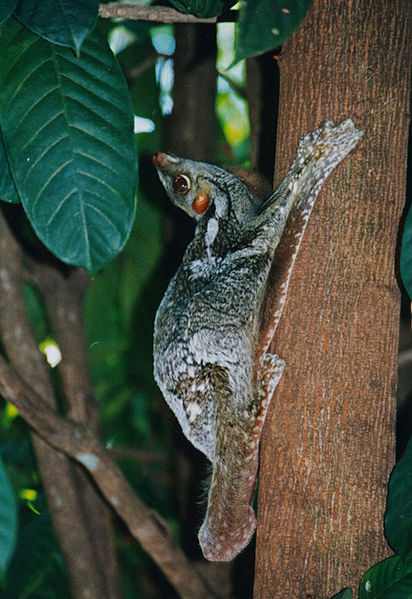 A flying lemur.
A flying lemur.
At between 33-42 cm in length, with a tail of 17.5-27 cm and a weight of 0.9-2kg, these lemurs are small animals, around the size of a domestic cat, and are covered in short, fine fur of a grey, red color, often with lighter flecks that mimic lichen-covered branches. It has a paler underbelly.
Like so many animals in Borneo and Sumatra, lemurs are little studied and there is a scarcity of information about their social lives, but they are known to be born after a gestation period of 2 months and are weaned at 6 months, and adults of this species are either solitary, or live in small, loose groups (Burnie, 2001).
Burnie, D. (2001). Animal. Dorling Kindersley, London.
Fredriksson G. et al. (2008). Helarctos malayanus. IUCN.
Hearn A. et al. (2008). Neofelis diardi. IUCN.
Lynam A. et al. (2008). Tapirus indicus. IUCN.
Van Strien N. J. et al. (2008). Dicerorhinus sumatrensis. IUCN.
WWF (2011). Sumatran elephants. World Wildlife Foundation.